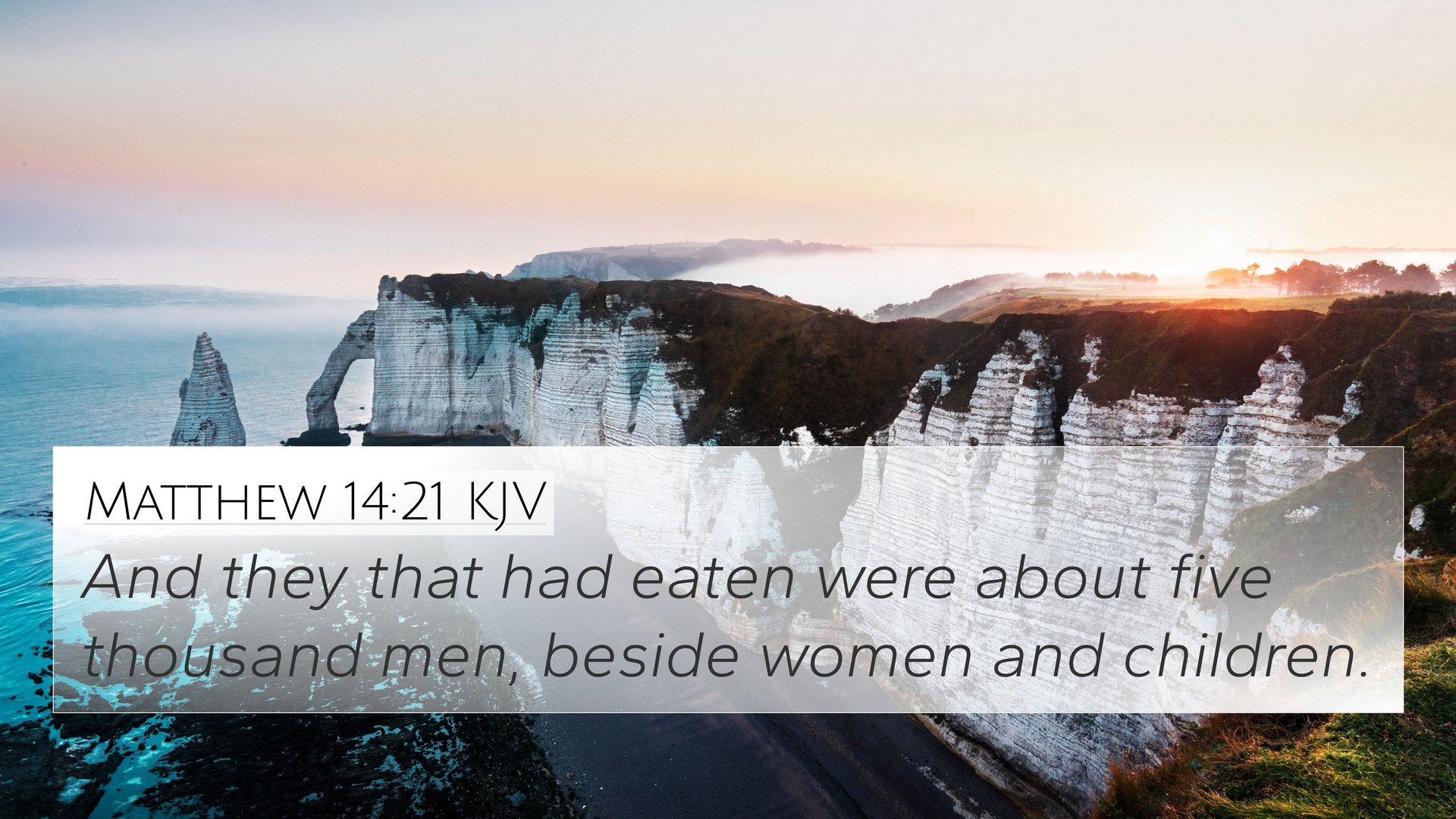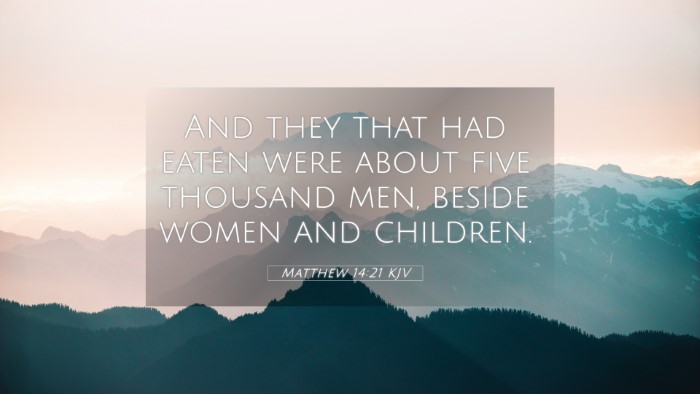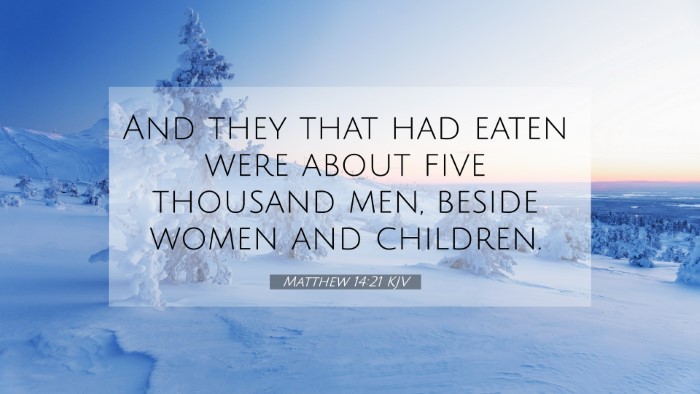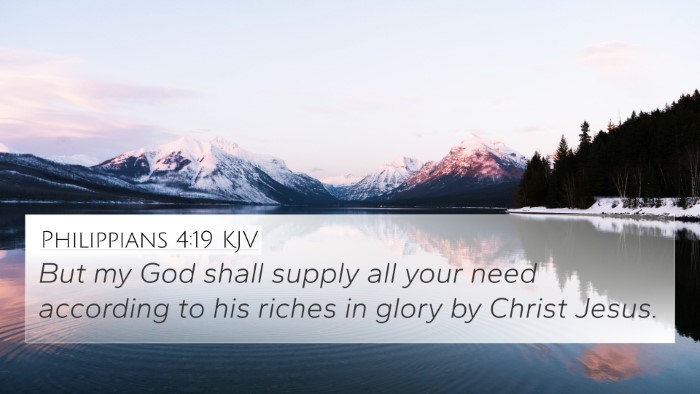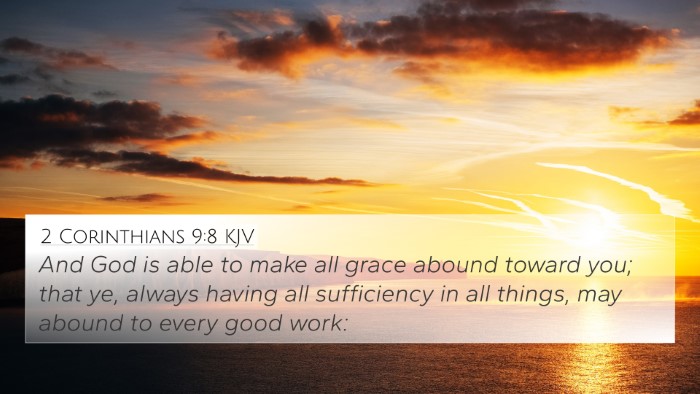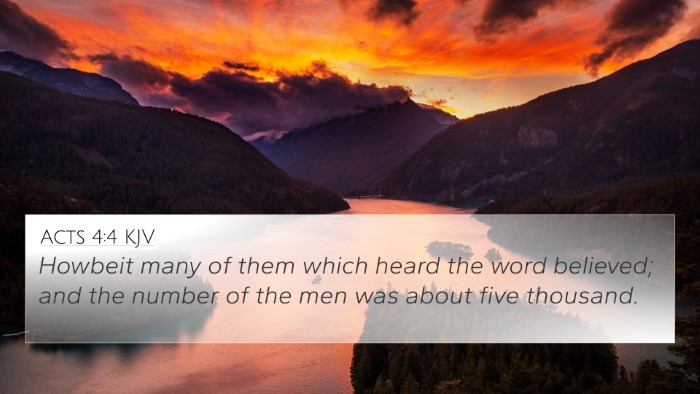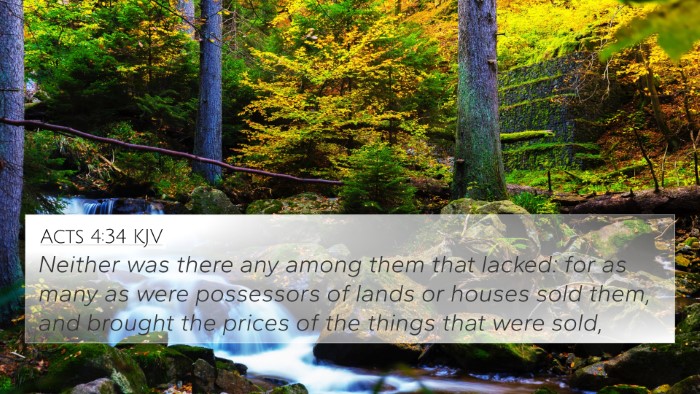Understanding Matthew 14:21
Matthew 14:21 states: "And they that had eaten were about five thousand men, beside women and children." This verse plays a significant role in the context of the miracle of the Feeding of the Five Thousand, which showcases Jesus' divine power and compassion. Below, we will explore the insights and interpretations drawn from various public domain commentaries.
Context and Significance
This miracle is recorded in all four Gospels, underscoring its importance in the ministry of Jesus. The feeding of this large crowd illustrates not only the provision of God but also serves as a precursor to the Last Supper and the spiritual nourishment found in Christ.
Commentary Insights
Matthew Henry's Commentary
Matthew Henry emphasizes the miraculous nature of the event, noting that such a multitude could not have been fed through human means. He highlights the abundance and sufficiency of Christ, suggesting that those who followed him found in Him the bread of life. Henry draws attention to the number of men, indicating that the actual count of people well surpassed five thousand when including women and children.
Albert Barnes' Notes on the Bible
Albert Barnes elaborates on the intentionality of the crowd and the faith displayed by Jesus' followers. He mentions that the disciples were initially hesitant about the need to feed the crowd, but Jesus' act of multiplication reflects His authority over creation and nourishes both body and spirit. Barnes notes that this event speaks to God's care for physical needs and points to the deeper spiritual truths found in Christ's teachings.
Adam Clarke's Commentary
Adam Clarke focuses on the logistics of the event and the planning involved in gathering and distributing the food. He acknowledges the societal implications of such a gathering, emphasizing Jesus' inclusivity as He cared for a diverse group of people. Clarke's analysis draws parallels to the Gospel’s call to minister to all individuals, illustrating the nature of Jesus’ ministry that transcends barriers.
Cross-References Related to Matthew 14:21
- John 6:1-14 - A deeper account of the feeding miraculously includes details about the boy who provided the loaves and fish.
- Mark 6:30-44 - Another account of the feeding of the 5,000, emphasizing the disciples' involvement.
- Luke 9:10-17 - Similar narrative reiterating the miraculous provision.
- Exodus 16:4 - God's provision of manna in the wilderness illustrates the theme of divine sustenance.
- Psalm 78:19-20 - Reflects on God's provision in the past while questioning His ability to feed them in the wilderness.
- Isaiah 25:6 - Prophetic imagery of God's provision of a rich banquet for His people.
- John 6:35 - Jesus declares He is the bread of life, connecting physical food with spiritual sustenance.
- 1 Corinthians 10:3-4 - Discusses Christ as the spiritual rock and provider during the Israelites’ journey.
- Philippians 4:19 - Assurance that God will supply every need according to His riches in glory.
- Matthew 15:32 - Another miracle of feeding, showing Jesus’ continued compassion for those who follow Him.
Theological Implications
This verse not only recounts a historical event but also invites profound theological reflection. The interplay between physical and spiritual nourishment is critical in understanding Jesus' mission. The miracle highlights the themes of abundance and trust in God’s provision, drawing connections across different Biblical texts.
How This Passage Relates to Other Scriptures
When analyzing the connections between Bible verses, we find a deep network of themes around God's provision, compassion, and the importance of faith in Jesus. This inclusivity emphasizes the need for followers of Christ to engage deeply with the text to uncover these layers:
- Jesus as the Bread of Life - He is not only feeding the physical hunger but also addressing spiritual needs.
- Discipleship and Service - This event involves the disciples in the act of feeding, linking service with faith.
- Community and Sharing - The gathering reflects the communal aspect of Jesus’ ministry, inviting shared involvement in miracles.
- Historical Context - Each Gospel's account helps us compare and analyze Jesus' methods and purposes.
- Old Testament Foreshadowing - Events like manna in the wilderness connect to Jesus as the ultimate provider.
- Celebration of Communion - The theological advancements culminate in the practices of the early Church.
Conclusion
Matthew 14:21 serves as a rich text for understanding Jesus’ miraculous provisions in both a literal and metaphorical sense. The cross-references to other verses within the Bible illustrate gods' continuous provision for humanity, emphasizing themes of faith, community, and the transcendental aspects of Christ's ministry. By examining this passage through the lenses of various commentaries and analyzing its connections, readers gain deeper insights into the holiness and compassion of Jesus.
Further Exploration
If you seek to understand the complexities and nuances of Scripture, employing tools for Bible cross-referencing can enhance your study. By utilizing a Bible concordance or a Bible cross-reference guide, you can uncover themes and connections that might otherwise remain hidden. Engage with the text deeply to identify connections between Old and New Testament themes, aiding your understanding of scriptural narratives.
